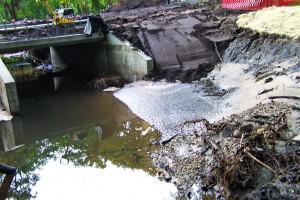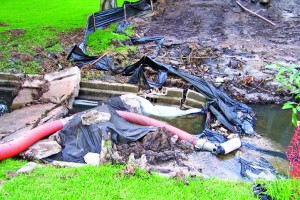Willowbranch Creek project cited for noncompliance
Posted on July 11, 2013 By Editor Articles, Neighborhood News, Top Stories
Construction dams break one week after warning

On June 26 the dam broke at the Willowbranch Creek construction site, a week after the project was cited for failure to maintain erosion and sediment controls – Photo by Jimmy Orth
The city claims “acts of God.” Local residents say it’s shoddy work and lack of compliance with environmental protection standards.
On June 26, both of the construction dams blew out at the Willowbranch and Riverside construction project, sending a significant amount of dirt into the creek. “They still have not done a good job managing the site, even after all of the scrutiny,” said Jimmy Orth, executive director for the St. Johns Riverkeeper.
The city’s Public Works Department had contracted with Touring Company, Inc. to widen the Riverside Avenue bridge over Willowbranch Creek and add sidewalks. The project originally began earlier this year then was stalled for more than eight weeks while the project plans were being redesigned to accommodate a conflict with utilities.
Shortly after recommencing construction, two storms came through in June and washed tons of dirt and sand into Willowbranch Creek, adding about 18 inches to the creek bed, according to Eric Reagan of Willowbranch Terrace.
“I’ve been observing this for quite some time; in the days leading up to [Tropical Storm] Andrea I noticed they weren’t doing anything to cover up the big mounds of dirt and sand,” Orth said. “When the rains finally came, nothing was done to divert the water to keep all the dirt from the creek.”
Orth jogged by after the hard, heavy rain on June 14 and noticed the steep gradient of exposed dirt along the sides of the creek and that the inadequate sediment fences around the construction site had been washed away.
“They [Touring Company] should have done a much better job of stabilizing the bank and managing the site. Instead, they’ve been running heavy equipment right up next to the trees. There is nothing in front of the storm drains,” Orth said. “They are creating a mess, and violating the law.”
The Florida Stormwater Erosion and Sedimentation Control Inspector’s Manual issues best management practices for erosion and sedimentation control. According to the manual (Section 3.2.3) “The operator is ultimately responsible for…implementing appropriate pollution prevention techniques to minimize erosion and sedimentation from stormwater discharges during construction.” The manual goes on to say that the contractor’s stormwater pollution prevention plan must ensure the implementation of best management practices that will be used to reduce the pollutants in stormwater discharge associated with construction activity.
When questioned on June 21 about the project site and the aftermath of the storms, Thomas McKnight, project manager, supplied a statement on behalf of the city, which stated, “The two storms in recent weeks both fall under the category of ‘acts of God’ (unforeseeable) where it is not possible to provide a cost-effective means of prevention. In other words, the storms were so large and infrequent that it was not anticipated. In both instances, the contractor worked immediately to stabilize the site and to re-establish the erosion and sediment controls. There were no sediment discharges from the site other than the two storm events.”

On June 26 the dam broke at the Willowbranch Creek construction site, a week after the project was cited for failure to maintain erosion and sediment controls – Photo by Jimmy Orth
Apparently, that’s not what nearby residents are experiencing.
According to the Riverkeeper’s office, the contractor dammed off the river from either side of the bridge to stop the flow of the creek, so that they could de-water the area between the dams where construction is taking place. Then, on the night of June 26, both dams blew.
“They are supposed to filter the muddy water that they remove rather than sending it down the storm drains or into the creek. The contractor should have taken much better precautions to prevent runoff. There was a lot of exposed dirt, the storm drains were not covered,” said a frustrated Orth. “It doesn’t cost that much for a contractor to comply with the law but it can be devastating for our creeks. Sedimentation can diminish property values, smother aquatic plants, and create turbidity that kills wildlife and aquatic organisms. These type of violations can have significant ecological and economic impacts.”
Touring Company Inc. will also feel the financial impact. Along with the Department of Public Works and CES Consultants (an environmental consultant), Touring Company was officially cited the week of June 17 with failure to maintain erosion and sediment controls, as required by Jacksonville Environmental Protection Board Rule 3.604A. According to Debbie Delgado, City of Jacksonville, the contractor faces remediation requirements plus could be fined up to $10,000 per each day that the problem is not resolved. At this time there is no indication whether a fine that steep would be incurred.
After the late June dam blow-out it was obvious that whatever measures the contractor put in place between the June 14 storm and the breach 12 days later, it wasn’t enough.
Residents on Willowbranch Terrance are frustrated, disgusted and very concerned.
Kathleen Murphy said of the whole project, “When I first heard about it I thought it was a great idea to widen the bridge over Riverside and add sidewalks on either side. The first red flag was the amount of time it was taking to complete the project. But…most recently, the new issue is environmental.”
She continued, “The amount of runoff and silt that has accumulated in the creek is unacceptable. It runs into our canal and then into the river. It’s been frustrating. I’m not an expert in that area but even I can tell that something’s not right. Let’s not make more of a mess. What they’ve done so far is like putting a bandage on a huge wound. If that cypress tree makes it, I’ll be surprised. They’ve over-dug, which creates more erosion.”
One resident who is somewhat of an expert with soil management is Reagan, who was a Seabee (the U.S. Navy’s Construction Battalion) and also worked for excavation companies.
Reagan knows contractors are held accountable by the Environmental Protection Agency for mitigating soil runoff. “They need to cover the dirt with plastic tarps and put in conduit to keep soil from running into creeks and waterways. At best, they did a haphazard job,” he fumed. “Tons of dirt and sand ran into Willowbranch Creek for days, now going on two weeks (as of June 21). They still have not done all the proper things, but did finally put up an earth dam. I’m not sure how they’re going to remove that from the creek when the project is done.”
Reagan reached out to Water Branch of Environmental Quality Division after the June 14 storm to see what could be done. And he’s not the only resident concerned about what’s going on – or not.
Sarah Nan, who lives close to Willowbranch Terrace, said “I am very concerned with the City of Jacksonville’s Public Works Department that is currently working on the Willowbranch Creek project. They appear to lack the ambition or knowledge to use Best Management Practices and procedures that are recommended and required by the Florida Department of Environmental Protection and the Environmental Protection Agency. The contractors are not protecting some of the storm drains from construction runoff, there are dirt piles that are uncovered, the site is very sloppy, the water is often turbid. Dirt from this site often flows to storm drain inlets and ultimately is discharged into Willowbranch Creek and as a result could possibly harm the ecosystem and clog up the creek and cause flooding during a rain event.’
Nan continued, “A failure to protect waterways from construction runoff may result in costly damage from a financial, aesthetic value, and environmental perspective, with us (as taxpayers) stuck with the bill to restore an area that has been damaged by careless or ignorant behavior. Construction site pollution prevention can reduce pollution into our rivers, streams, and nearest waterways and would be appreciated if practiced by the city of Jacksonville’s Public Works department. The city should lead by example and show how protection of our natural resources are important and they know better (or I would hope) about how important it is to protect our waterways.”
Nan observed that one of the first rules discussed during Stormwater Management Classes is “never let dirt leave your site.”
By Kate A. Hallock
Resident Community News




 (1 votes, average: 5.00 out of 5)
(1 votes, average: 5.00 out of 5)




